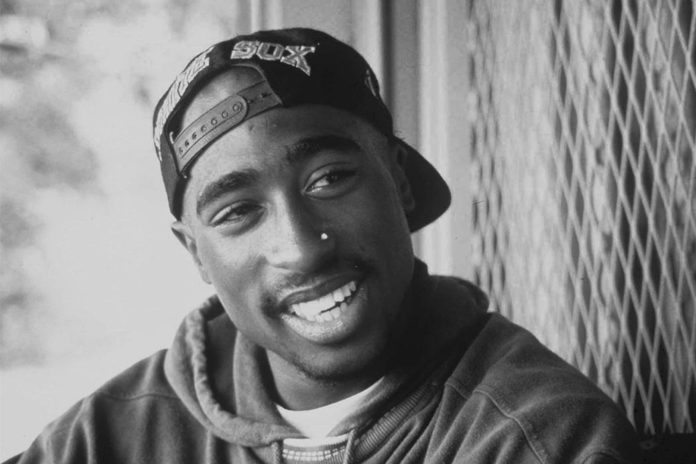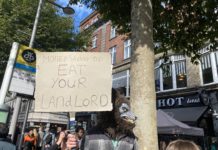In a recent interview with Pitchfork, Nahshon Anderson, a former intern at Tupac’s film company Look Hear Creations, was asked what the late rapper would be doing had he lived. “I can’t imagine what he wouldn’t have been doing,” replied Anderson.
Tupac Amaru Shakur II was born Lesane Parish Crooks on June 16, 1971, in East Harlem. He should be celebrating his 50th birthday this month.
At 4:03 p.m. on Sept. 13, 1996, he succumbed to his wounds after being shot six days previously in Las Vegas. His murder, which remains officially unsolved, has been mythologised and questioned over the intervening years. Seventh Day Tupac believers cling to the frequency of the number seven throughout his life. He was shot on 7th September, aged 25 (2+5), he officially died at 4:03 p.m. (4+0+3=7), his birthday is the 16th June (1+6). Some held he would return seven years after his “death”. That has not come to pass.
A recent Netflix documentary series Unsolved: The Murders of Tupac & The Notorious B.I.G. featured cryptic testimony from Duane Keith Davis. Last Man Standing: Suge Knight and the Murders of Biggie & Tupac, an intriguing new documentary by Nick Broomfield, probes the gang culture around Suge Knight and the links between criminal gangs, the Death Row record label, and law enforcement.
Amateur theorists have noted that the man paid to cremate Tupac’s body by Death Row Records CEO Knight – himself a prime suspect in Tupac’s murder – has disappeared without a trace. Tupac’s stage name Makaveli – a play on Niccolò Machiavelli – is an anagram of “Am Alive K”. A widely disseminated 2004 video places Tupac – or someone with a similarly shaped head – in Cuba.
It’s a romantic idea, one that Eminem has rapped about: “Hip-hop ain’t been the same since Tupac moved to Cuba on us”.
The truth, however, is much murkier than the most extravagant imaginings.
The FBI War on Tupac Shakur and Black Leaders, a scholarly and explosive 2007 analysis by American investigative journalist John Potash, locates Tupac’s death within the larger and shadowy context of the FBI’s COINTELPRO programme.
Potash’s 2015 book, Drugs As Weapons Against Us expands on his earlier thesis using hundreds of interviews, thousands of documents, and 12 years of research. Writing in Drugs As Weapons Against Us, Potash claims that Tupac was killed for politicising street gangs.
As Potash notes, long before Tupac rapped “Some say the Government will watch me/But they can’t stop me”, he was a political and politicised figure.
Tupac’s mother, Afeni Shakur, was one of 21 members of the Black Panther party put on trial in New York in 1969 for allegedly plotting to shoot and bomb two New York City police stations. It was the most expensive trial in New York history. The pregnant Shakur defended herself, despite having no legal education. The trial ended with an acquittal of all defendants.

She named her son after Túpac Amaru, the last Incan monarch, who was hunted down and publicly executed by the Spanish. Speaking in the Quechuan language, the deposed king told the attending Catholic bishop and his followers: “Pacha Kamaq, witness how my enemies shed my blood.”
As a teenager, Tupac joined the Baltimore chapter of the Young Communist League and later the Communist Party USA. His stepfather, Mutulu Shakur, spent four years listed among the FBI’s Ten Most Wanted Fugitives.
“Tupac grew up within a family of Black Panther leaders,” says Potash. “His mother was a Black Panther leader In Harlem. She was an amazing woman who was credited by the jurors with getting the Panther 21 off in court in what was the longest trial in New York history at that time. Under the auspices of the FBI counterintelligence programme, every means possible were used to frame and murder Black Panther leaders around the country. And they were successful, of course, with Fred Hampton. They were successful with Huey Newton.
“In my book, I go into these various assassinations and analyse them as the background for what happened to Tupac. There was an FBI counterintelligence programme agent named Wes Swearingen who wrote a memoir (1995’s FBI Secrets: An Agent’s Exposé) and he was part of the Los Angeles FBI unit that targeted Tupac’s godfather, Geronimo Pratt. Pratt was the head of the Los Angeles Black Panthers. Swearingen said that the FBI tried to murder Geronimo Pratt. They shot up his bed but he was sleeping on the floor because of a bad back from being in the Vietnam War. In 1971, activists broke into an FBI office and got FBI documents that exposed the counterintelligence programme for the first time. (The anti-Vietnam War activists who raided the FBI office in Media, Pennsylvania stole over 1,000 documents which revealed – among other things – the FBI’s efforts to foment violence against Fred Hampton and the Chicago Panthers.) The FBI basically had a programme to assassinate leftist leaders in general, and target the anti-war movement and the civil rights movement, and murderously target different leaders of these different movements.
“Swearingen says that even though they closed down the programme in 1971 – because of all the revelations in these documents – they unofficially kept it open under other names up until – at least – the mid-1990s when Tupac was becoming a major leader. Tupac, when he was 17 years old, was an elected head of the new African Panthers, which was a group trying to replicate the Black Panthers and was active in eight to 10 cities. So at 17 years old, he was already a national leader. He only left that position to tour with the Digital Underground. When he got a solo record deal and an MTV worldwide release, within days police stopped, supposedly for jaywalking, and proceed to choke him unconscious and smashed and banged his head against the curb until he was black and blue. I believe this was the first attempt to kill him.”
It was the first of many similar attempts. In Atlanta, “two supposedly off duty cops” as Potash describes them, used the gun they stole from an evidence locker to shoot at Tupac. Writing in Drugs As Weapons Against Us, Potash claims that Tupac was ultimately killed for politicising street gangs.
“By the time he turned 20 or so he’s gotten a record deal and he’s making it big as a star of the film Juice. And then he’s in Poetic Justice with Janet Jackson. And so he developed a new plan right after his first album, 2pacalypse Now. That plan was part of his extended Black Panther family’s plan, to politicise gangs, to make peace treaties, and try to get them to start fighting racism. His business manager confirmed to me that he only pretended to be a gangster like gangster rapper in order to politicise gangs and keep them moving with this peace movement. He ends up getting Bloods and Crips leaders to shake hands and agree to what he called a code of Thug Life. That movement, that Thug Life movement, started in LA in 1992, and then spread throughout California and throughout the country. He brokered a peace truce in New York, in Brooklyn. And in New York, the Latin Kings were inspired by it, and some of the Young Lords – which were the Latino version of the Black Panthers – got involved.
“And then, in 1995, New York launched something called Operation Crown, where they had 1000 different agents, in the middle of the night and arrest all these of 91 of the top Latin Kings and Queens, arrest them for no reason, search their house, search their cars. They don’t find a single drug or a single gun. And yet they still arrest them. The Latin Kings were notoriously murderous and notoriously drug dealing before they turned on to activism. They were drugged, they were all drug dealers, and not all but most of them were drug dealers. But once they completely stopped drug dealing, that was a major issue. The CIA is the biggest drug traffickers in our country. When you take all these drug dealers and turn them into activists, it’s a major blow to the profits of the CIA.”
There remain some troubling contradictions about Tupac. How did a socially-conscious young tyro, one who excelled at jazz, poetry, dance, and Shakespeare at the Baltimore School for the Arts, get so caught up in the gangster rap lifestyle? How did his mother, before him, as the song Dear Mama recounts, go from being the brilliant architect of the Panther 21 defense to a crack addict?
The answers are disturbing.
“She’s lecturing in Ivy League universities around the country,” says Potash. “She’s a celebrity from the Black Panthers and nationwide, everyone wanted to hear speak, because of how important she was. This woman who never graduated college took on the unlimited resources of New York. She worked on getting Geronimo Pratt out of jail and worked with a bunch of activists and lawyers against New York City laws that allow the police to trample on constitutional rights.
“While she’s doing that, the FBI follows her around and starts trying to get her fired from a bunch of different jobs. She’s broke and beleaguered. They chased her partner Mutulu Shakur – who was the director of the first acupuncture clinic for drug treatment in the country – underground. She’s poor, destitute, trying to raise Tupac and his half-sister. And here comes Lake Saunders into her life. Lake Saunders has all kinds of money. He’s a crack dealer. He’s working for Nicky Barnes, who the New York Times called Mr. Untouchable. Nicky Barnes was the understudy of another top cocaine dealer on the East Coast. In court, it was discovered that there were about nine people associated with him who were part of the CIA.
“Lake Saunders came into Afeni Shakur’s life to get her addicted to crack. And he was successful. I mean, they psychologically profile activists like this, to find their weaknesses. And she developed an addiction. But Tupac made it out of there. She moved to Baltimore and got Tupac into the bottom of School for the Arts. He rewrote Shakespeare plays into modern language and produced, directed, and starred in them. He had read hundreds of PhD-level books before his teen years. He had an amazing mind and he was a charismatic guy, and people loved him.
“The problem was when he decided to develop that Thug Life plan and pretend to be this gangster in order to appeal to the gangs and politicise them. He presented himself in a negative way to follow through with this plan because he was not a gangster type at all beforehand. But then sent him to jail for 11. They sent him to a maximum-security prison for what official court documents describe as touching a woman’s butt against her will, a woman who said they had consensual sex. And it just came out in Esquire magazine just a few days ago. The jurors said, there was just one woman who thought he was guilty of everything. She wouldn’t listen to any of the evidence. The other jurors couldn’t take being stuck with her and they didn’t want it to be a hung jury. They couldn’t take being sequestered for weeks for this crap. And so they decided just to say, Okay, well, he touched her butt against her will. So, once they got that – which really should be a misdemeanour – he’s sentenced to jail from one and a half to four and a half years in a maximum-security prison.”
“There, they used what they call penal coercion against him. And penal coercion is what Amnesty International calls the closest thing to brainwashing we have in the United States. They used every tactic of penal coercion against Tupac to mess up his mind. And this includes every time someone will visit him in jail, they would stick their gloved fingers up his butt, saying they’re looking for contraband, even though the whole visit was watched by the guards. They tortured him in that way. When he comes out of jail, his closest friends like Jada Pinkett Smith say he was a shell of himself. They put him in solitary confinement for 10 straight months, which they know can make people insane. And then they let them out to undercover agents. Suge Knight was like a low rung on the totem pole. But he was obviously an undercover agent.”
It’s always tricky to consider counterfactuals, but it is, more tantalising and saddening to consider who Tupac might have been at 50.
“It’s weird to quote an NBA basketball player, but it’s worth it because Kevin Duran has listened to a lot of Tupac’s political interviews, and he says that had Tupac lived, he would have been Martin Luther King or another Gandh,” says Potash. “I agree. I mean, he could have been the best kind of political force in this country. He was so beloved by whites and blacks and Latinos. He was beloved by his friends and the people with who he co-starred, like Jim Belushi, Janet Jackson, Tim Roth, and Mickey Rourke. He was so incredibly productive before he died at 25. There were hundreds and hundreds of songs produced that didn’t get released. He was a great actor. His teachers at the Baltimore School for the Arts told me was the best actor they ever had. He was giving money regularly to his Black Panther mentors. He was funding black activist leaders as best he could. He could have really changed things.”
Drugs as Weapons Against Us: The CIA’s Murderous Targeting of SDS, Panthers, Hendrix, Lennon, Cobain, Tupac and other Activists and The FBI War on Tupac Shakur and Black Leaders: U.S. Intelligence’s Murderous Targeting of Tupac, MLK, Malcolm, Panthers, Hendrix, Marley, Rappers & Linked Ethnic Leftists are available at www.johnpotash.com/books-dvds/.





